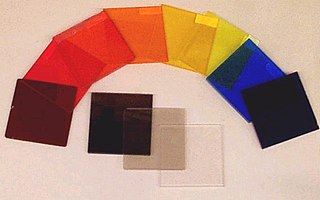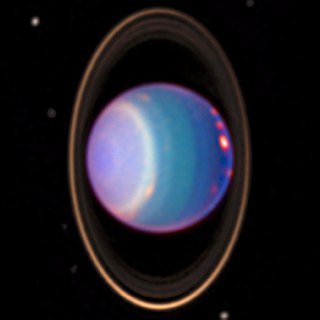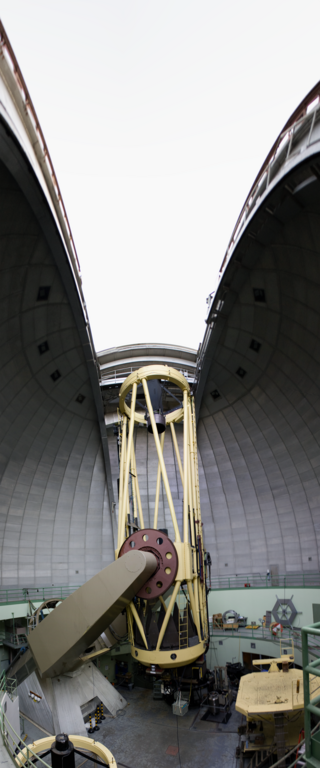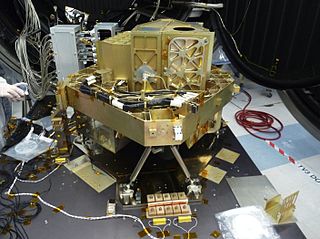
A charge-coupled device (CCD) is an integrated circuit containing an array of linked, or coupled, capacitors. Under the control of an external circuit, each capacitor can transfer its electric charge to a neighboring capacitor. CCD sensors are a major technology used in digital imaging.

The Very Large Telescope (VLT) is a facility operated by the European Southern Observatory, located on Cerro Paranal in the Atacama Desert of northern Chile. It consists of four individual telescopes, each equipped with a primary mirror that measures 8.2 meters in diameter. These optical telescopes, named Antu, Kueyen, Melipal, and Yepun, are generally used separately but can be combined to achieve a very high angular resolution. The VLT array is also complemented by four movable Auxiliary Telescopes (ATs) with 1.8-meter apertures.

Subaru Telescope is the 8.2-metre (320 in) telescope of the National Astronomical Observatory of Japan, located at the Mauna Kea Observatory on Hawaii. It is named after the open star cluster known in English as the Pleiades. It had the largest monolithic primary mirror in the world from its commissioning until the Large Binocular Telescope opened in 2005.

The Large Binocular Telescope (LBT) is an optical telescope for astronomy located on 10,700-foot (3,300 m) Mount Graham, in the Pinaleno Mountains of southeastern Arizona, United States. It is a part of the Mount Graham International Observatory.

The W. M. Keck Observatory is an astronomical observatory with two telescopes at an elevation of 4,145 meters (13,600 ft) near the summit of Mauna Kea in the U.S. state of Hawaii. Both telescopes have 10 m (33 ft) aperture primary mirrors, and, when completed in 1993 and 1996, they were the largest optical reflecting telescopes in the world. They are currently the third and fourth largest.

An optical coating is one or more thin layers of material deposited on an optical component such as a lens, prism or mirror, which alters the way in which the optic reflects and transmits light. These coatings have become a key technology in the field of optics. One type of optical coating is an anti-reflective coating, which reduces unwanted reflections from surfaces, and is commonly used on spectacle and camera lenses. Another type is the high-reflector coating, which can be used to produce mirrors that reflect greater than 99.99% of the light that falls on them. More complex optical coatings exhibit high reflection over some range of wavelengths, and anti-reflection over another range, allowing the production of dichroic thin-film filters.

An optical filter is a device that selectively transmits light of different wavelengths, usually implemented as a glass plane or plastic device in the optical path, which are either dyed in the bulk or have interference coatings. The optical properties of filters are completely described by their frequency response, which specifies how the magnitude and phase of each frequency component of an incoming signal is modified by the filter.

The Near Infrared Camera and Multi-Object Spectrometer (NICMOS) is a scientific instrument for infrared astronomy, installed on the Hubble Space Telescope (HST), operating from 1997 to 1999, and from 2002 to 2008. Images produced by NICMOS contain data from the near-infrared part of the light spectrum.

The NASA Infrared Telescope Facility is a 3-meter (9.8 ft) telescope optimized for use in infrared astronomy and located at the Mauna Kea Observatory in Hawaii. It was first built to support the Voyager missions and is now the US national facility for infrared astronomy, providing continued support to planetary, solar neighborhood, and deep space applications. The IRTF is operated by the University of Hawaii under a cooperative agreement with NASA. According to the IRTF's time allocation rules, at least 50% of the observing time is devoted to planetary science.
Spectral imaging is imaging that uses multiple bands across the electromagnetic spectrum. While an ordinary camera captures light across three wavelength bands in the visible spectrum, red, green, and blue (RGB), spectral imaging encompasses a wide variety of techniques that go beyond RGB. Spectral imaging may use the infrared, the visible spectrum, the ultraviolet, x-rays, or some combination of the above. It may include the acquisition of image data in visible and non-visible bands simultaneously, illumination from outside the visible range, or the use of optical filters to capture a specific spectral range. It is also possible to capture hundreds of wavelength bands for each pixel in an image.

Hyperspectral imaging collects and processes information from across the electromagnetic spectrum. The goal of hyperspectral imaging is to obtain the spectrum for each pixel in the image of a scene, with the purpose of finding objects, identifying materials, or detecting processes. There are three general types of spectral imagers. There are push broom scanners and the related whisk broom scanners, which read images over time, band sequential scanners, which acquire images of an area at different wavelengths, and snapshot hyperspectral imagers, which uses a staring array to generate an image in an instant.

The C. Donald Shane telescope is a 120-inch (3.05-meter) reflecting telescope located at the Lick Observatory in San Jose, California. It was named after astronomer C. Donald Shane in 1978, who led the effort to acquire the necessary funds from the California Legislature, and who then oversaw the telescope's construction. It is the largest and most powerful telescope at the Lick Observatory, and was the second-largest optical telescope in the world when it was commissioned in 1959.

A telescope is a device used to observe distant objects by their emission, absorption, or reflection of electromagnetic radiation. Originally it was an optical instrument using lenses, curved mirrors, or a combination of both to observe distant objects – an optical telescope. Nowadays, the word "telescope" is defined as a wide range of instruments capable of detecting different regions of the electromagnetic spectrum, and in some cases other types of detectors.

The Daniel K. Inouye Solar Telescope (DKIST) is a scientific facility for studies of the Sun at Haleakala Observatory on the Hawaiian island of Maui. Known as the Advanced Technology Solar Telescope (ATST) until 2013, it was named after Daniel K. Inouye, a US Senator for Hawaii. It is the world's largest solar telescope, with a 4-meter aperture. The DKIST is funded by National Science Foundation and managed by the National Solar Observatory. The total project cost is $344.13 million. It is a collaboration of numerous research institutions. Some test images were released in January 2020. The end of construction and transition into scientific observations was announced in November 2021.
Teledyne e2v is a manufacturer with its headquarters in England, that designs, develops and manufactures systems and components in healthcare, life sciences, space, transportation, defence and security and industrial markets. The company was previously known as English Electric Valve Company and for a short time Marconi Applied Technologies. e2v was acquired by US company Teledyne Technologies in March 2017.

The NIRSpec is one of the four scientific instruments flown on the James Webb Space Telescope (JWST). The JWST is the follow-on mission to the Hubble Space Telescope (HST) and is developed to receive more information about the origins of the universe by observing infrared light from the first stars and galaxies. In comparison to HST, its instruments will allow looking further back in time and will study the so-called Dark Ages during which the universe was opaque, about 150 to 800 million years after the Big Bang.

Fine Guidance Sensor and Near Infrared Imager and Slitless Spectrograph (FGS-NIRISS) is an instrument on the James Webb Space Telescope (JWST) that combines a Fine Guidance Sensor and a science instrument, a near-infrared imager and a spectrograph. The FGS/NIRISS was designed by the Canadian Space Agency (CSA) and built by Honeywell as part of an international project to build a large infrared space telescope with the National Aeronautics and Space Administration (NASA) and the European Space Agency (ESA). FGS-NIRISS observes light from the wavelengths of 0.8 to 5.0 microns. The instrument has four different observing modes.

NIRCam is an instrument aboard the James Webb Space Telescope. It has two major tasks, as an imager from 0.6 to 5 μm wavelength, and as a wavefront sensor to keep the 18-section mirrors functioning as one. In other words, it is a camera and is also used to provide information to align the 18 segments of the primary mirror. It is an infrared camera with ten mercury-cadmium-telluride (HgCdTe) detector arrays, and each array has an array of 2048×2048 pixels. The camera has a field of view of 2.2×2.2 arcminutes with an angular resolution of 0.07 arcseconds at 2 μm. NIRCam is also equipped with coronagraphs, which helps to collect data on exoplanets near stars. It helps with imaging anything next to a much brighter object, because the coronagraph blocks that light.

MIRI, or the Mid-Infrared Instrument, is an instrument on the James Webb Space Telescope. MIRI is a camera and a spectrograph that observes mid to long infrared radiation from 5 to 28 microns. It also has coronagraphs, especially for observing exoplanets. Whereas most of the other instruments on Webb can see from the start of near infrared, or even as short as orange visible light, MIRI can see longer wavelength light.

The Infrared Array Camera (IRAC) was an infrared camera system on the Spitzer Space Telescope which operated in the mid-infrared spectrum. It was composed of four detectors that operated simultaneously at different wavelengths; all four were in use until 2009 May 15 when the Spitzer cryostat ran out of liquid helium. After then, the spacecraft operated in a warm extended mission, in which two of the four detectors remained functional, until the Spitzer mission was terminated on 2020 January 30.


















